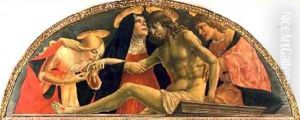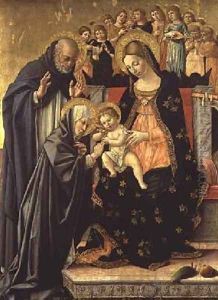(Salimbeni) Lorenzo da Sanseverino Paintings
Lorenzo di Alessandro da San Severino, also known as Lorenzo Salimbeni, was an Italian painter of the Gothic style during the early Renaissance period. Born around 1374 in San Severino Marche, in what is now the province of Macerata in the Marche region of Italy, Lorenzo's artistic activities are documented between the years 1394 and 1429, although the exact dates of his birth and death are not clearly established.
Lorenzo was part of the Salimbeni family of painters, which also included his brother Jacopo. They were likely taught by their father, but little is known about their early training. The brothers worked together on various commissions, and their collaborative efforts are noted for blending the international Gothic style with emerging Renaissance sensibilities.
One of Lorenzo's most significant contributions to art history is his work on the fresco cycle in the Oratorio di San Giovanni in Urbino, which he executed with his brother between 1416 and 1419. These frescoes depict scenes from the life of John the Baptist and are celebrated for their vibrant colors, attention to detail, and expressive figures. Lorenzo's style is characterized by a refined use of line and a tendency towards elegant and elongated figures, an inheritance from the prevailing Gothic aesthetic. However, he also began to incorporate a greater sense of volume and perspective into his work, indicating an awareness of the innovations of his Florentine contemporaries.
Despite his contributions, Lorenzo's work was somewhat overshadowed by the developments in Florence and other major art centers. Nevertheless, his paintings are an important representation of the Marchigian school of painting, which contributed to the spread of Renaissance ideas throughout Italy. Lorenzo's exact date of death is uncertain, but it is believed that he passed away around 1445. His legacy lives on through the works he left behind, which continue to be studied for their blend of Gothic elegance and nascent Renaissance principles.

